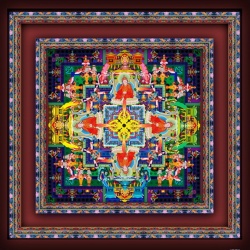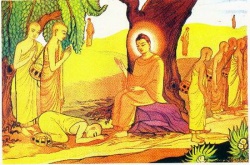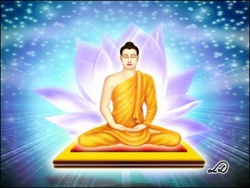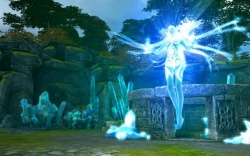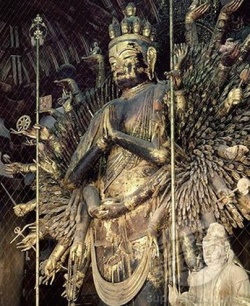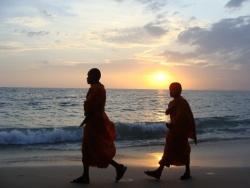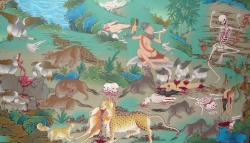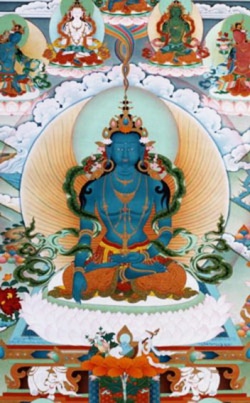The Profound Meaning of Buddhist Ceremonies
Buddhism is one of the world's great religions, originating in a Himalayan kingdom, the present-day northern India. It derived from the teachings of Buddha, who is regarded as one of a series of such enlightened beings. The only complete canon of the Buddhist scriptures is that of the Sinhalese (Sri Lanka) Buddhists, in Pali, but other schools have essentially the same canon in Sanskrit. The scriptures are known as Pitakas or 'baskets'. There are three divisions: Vinaya or Discipline, listing offences and rules of life; Sutta or Discourse or Dhamma or Doctrine, the exposition of Buddhism by Buddha and his disciples; Abhidhamma or Further Doctrine, later discussions on doctrine.
The most important belief of this doctrine is that of karma, good or evil deeds meeting an appropriate reward or punishment either in this life or (through transmigration or rebirth) in a long succession of lives. The self is not regarded as permanent. The aim of the Noble Eightfold Way is to break the chain of karma, and achieve dissociation from the body by attaining Nirvana 'blowing out', the eradication of all desires, either in annihilation, or by absorption of the self in the infinite. There are no gods, but great reverence is accorded to Buddha, and other such advanced incarnations.
Based on health, wisdom, and environment, Lord Buddha categorized the behavior of human beings into three different groups. He envisioned that his followers would have three different ways of practice along the line of worship or ceremonies which were not included in Buddhism philosophy whatsoever. He realized that sooner or later his followers would develop something else along with their faith in Buddhism.
Elementary Level : Common laymen believe in Buddhism according to a shallow understanding. In addition to their limited knowledge, these people created ceremonies and traditions which are far away from scientific principles. Among the followers, they particularly follow animism (belief in all kinds of god, spirit, ghost, etc.) and attached this to Buddhism. In order to pay respects to those non-beings, ceremonies were created and became traditions. Some are tolerable, but some others are not.
Secondary Level : These are the "middle-of-the-road" Buddhists who believe in something that should be believed and do not believe something that is not appropriate. Some ceremonies or traditions are accepted by these people who have a fair background in education, experience, maturity, behavior, etc.
Tertiary Level : These Buddhists believe and follow only Buddhism philosophy. They do not believe or follow any kind of nonsense. To them, nothing else except Buddhism philosophy is only principle that leads them to peace and happiness. These people have higher education, full of experience, much maturity, and polite behavior. They are not interested in ceremonies and traditions.
Buddhists in almost all levels have developed and created ceremonies which eventually became traditions for successive generations as time has gone by during the past twenty-five centuries. Many of the things which today symbolize Buddhism have been "man-made" since the Buddha's death. Relatively few things remain, in fact, which allow us to immediately, instinctively recall the Buddha as a flesh-and-blood man, reflecting the simple yet great teacher he was. Actual images of the man, for instances, did not appear until some five centuries after his death. He himself certainly would not have appreciated being worshipped as a god nor did he believe in miracles. Would he be saddened to know that nowadays some people pray to him for material changes in their life, and sometimes even for lottery numbers!! Some things which do help us to recall the man himself would include a simple robe, an alms bowl, and Bhodi tree.
On holy days as well as any day that Buddhist followers choose to pay respect to the "Triple Gems", the definition of our heritage as listed below:-
The Lord Buddha, the Greatest Teacher
The Dhamma, Lord Buddha's teachings or doctrine
The Sangha, the Buddhist monkhood in Thailand
The ceremonies, traditions, and culture of Buddhists around the world are different due to their individual geography, environment, times, and race. The heritage of Thai Buddhists are based on ceremonies, traditions and culture can be categorized in to 2 main groups as follows :
Functional Places of Worship (Sasana Satharn)
Wiharn
Pra Ubo-Sote
Gooti
Various kinds of Sala
Various kinds of Hor or tower
Jedee or Pagoda
etc.
Functional Offering of Worship (Kreaung Sakarah)
Offerings to Lord Buddha
Offerings to Dhamma
Offerings to Monks
Offerings to the "Triple Gems"
With reference to the cover story of our June 1998 issue, we would like to discuss 11 different worship offerings to Lord Buddha as follows :
1. Phra Buddha Roob (Buddha Images)
As a matter of fact, not long ago after Lord Buddha's death, his followers started to create various symbols which were regarded as worship offerings to the Great Teacher for the following 300 years. A deer represents one of animals surrounding Buddha when he was living. Symbols of the four virtues being the four wheels of a carriage, constitute the means of prosperity. After three centuries, Emperor Alexander of Macedonia or Greece sent his troops to conquer the area of present-day northern India. He also sent his sculptors and other craftsmen along with those troops. Later on these sculptors became Buddhist followers. Various materials had been used for the sculpture of Lord Buddha images, e.g. stone, wood, precious stone, silver, gold, copper, lead, brass (copper+zinc), bronze, gold bronze (red gold) are among the most popular. In Lanna northern Thailand, the craftsmen knew how to apply zinc onto brass resulting in "Thong Naam Pu." Furthermore, the appearance of Buddha images indicated the school of the craftsmen, such as Panjala, Amaravati, Dvaravati, Srivijaya, Lopburi, Chiang Saen or Lanna, Sukhothai, U-Thong or Ayuthaya, and Bangkok.
Certain mudras -- hand gestures and body postures -- commonly appear in Thai Buddha images. The Buddha is shown as standing, sitting, walking or reclining. The reclining mudra signifies the Buddha entering Nirvana. The most common mudra for Thai images is the Buddha sitting in a half-lotus position (one leg on top of the other, but not with the ankles crossed with both soles up, as in the full-lotus; the full-lotus position is characteristic of Burmese Buddha images). In addition the fingertips of the Buddha's right hand are pointing toward the ground, while his left hand is resting in his lap with his palm upwards. This mudra represents the Buddha's victory over Mara (the Tempter, the forces of greed, hatred and delusion) and the mudra is called the Bhumisparsa Mudra or "Calling the Earth to Witness."
Additionally, for those people who are superstitious especially about birthdays according to the weekdays, small Buddha images are molded or cast based on the above postures. Names were given to these images, i.e. Phra Thawye Net, Phra Haam Samoot, Phra Saiyas, Phra Oombaat, Phra Naang Samadhi, Phra Rum Peung, Phra Naga Prog --- for those who were born on Sunday, Monday, Tuesday, Wednesday, Thursday, Friday, and Saturday respectively.
Historically, Buddha images in Lanna have shown the sculptures in three different designs as follows :
Prom Laksana (Brahma Style) : The body posture is straight up in handsome poise. It resembles the creator of the world who is sitting in front of his followers while leading them to happiness by means of Buddhist philosophy. An example of this design can be seen at Wat Suan Dork.
Siha Laksana (Lion Style) : The design indicates a strong and powerful body. The Buddha image appears to be a brave and respectful leader that presides in front of the followers who have faith in him. People can see this style of Buddha image at Wat Phra Singh
Buddha-Laksana (Samadhi or Meditation) : The design shows straight body with eyes down toward the followers. The image seems to have humbleness, calmness, and mindful concentration. This style of Buddha image can be seen at Wat Chiang Mun.
2. Asna (Pulpit)
The Asna is regarded as Lord Buddha's seat which is similar to a king's throne. The Lord Buddha was a prince before he left the palace to find the answers in the forest. Of course he endured a simple way of life during his preaching times. However, with great esteem, worshippers created this symbol which related to his princely lifestyle. At times the creation of the seat has been out of proportion to the real purpose, such as overly high platform, a four poster bed with decorative canopy, and all kinds of gaudy decoration. Visitors can visit and see Asna at Wat Mae Rim.
3. Saad Baang (Cushion)
This is a mattress with the appearance of a flying lemur or squirrel. The mattress itself is made of banana leaves, bamboo, or Khun Phaen weed. The size must be big enough to cover Asna. The weaving and adornment would be very beautiful for this symbol of great honor to Lord Buddha.
4. Mawn Pha (Mawn Kwan or Mawn Saam Liam)
This is a triangle pillow which is used as a back rest, or for putting on one's lap, or as an arm rest while sitting on the floor. Weaving or sewing all kinds of patterns and designs make this triangle pillow beautiful as well as serving a practical purpose.
5. Raj Gagoothapun (Royal Regalia)
There are five precious objects, each with their own special symbolism; which make up the Royal Regalia. The Quintet Royal Regalia, especially important as a symbol of kingship, comprise a total of five items :
Pra Maha Phichai Mongkut or The Great Crown of Victory
Pra Saeng Khan Chai Sri or The Great Sword of Victory
Tharn Phra Gorn Chaipruek or The Royal Staff or cane
Walwichani or The Royal Fan and The Royal Fly whisk
Chalong Phra Baat Chern Ngorn or The Royal Upturned Slippers.
6. Khao Madhupayas (Auspicious Rice)
This is an auspicious milk-rice cooked with honey, molasses, beans, sesame seed, milk, butter, and coconut cream. Lanna people prepare Madhupayas Rice several times a year for ceremonies that pay respect to Prince Siddhartha. This food preparation came to be from the following parable.
Several months before Prince Siddhartha became enlightened, Suchada, a wife of rich man in that area came to the Bhodi tree that had many big branches. She was childless but hoped to have a child. The shady, bountiful Bhodi tree convinced her there might be a God staying under the tree. She went over and kneeled down. She asked God to grant her wish for a son. She departed for home. Not much longer after that, she became pregnant and had a little boy.
She returned to the Bhodi tree to give thanks. It was on the day (with full moon night) in the middle of 6th lunar month (considered to be the 8th month in the north), Lord Buddha was in the process of becoming enlightened, Suchada was struck with Lord Buddha's handsomeness. She worshipped him saying "Lord, accept what I have offered you and depart whenever you please. Even as my wish has been fulfilled may yours also be well fulfilled!!" And she went away with no more desire for the return of the golden bowl worth a hundred-thousand Kahapanas than for a withered leaf.
7. Loy Thaad (Floating Golden Bowl and Tray)
The parable continues with the symbol of the bowl and tray. Having partaken of that milk-rice, Prince Siddhartha took the golden bowl and tray and set it adrift saying. "If I shall succeed in becoming a Buddha this day, let this bowl and tray go upstream; if not, let it go down with the current." Cutting its way through the current, it went to the middle of the river and proceeded against the current for a distance of eighty cubits keeping to a central course, as fast as a swift horse ... And Prince Siddhartha, having spent the noonday heat meditating in the blossoming sala grove on the bank of the river, wended his way at eventide, like a lion shaking off his drowsiness, in the direction of the Bhodi Tree. The flowers untimely dropped off from their stems.
As Prince Siddhartha was meditating, his mind concentrated and purified, he finally developed the supernormal knowledge that ultimately destroyed all kinds of passions and mental defilements in him and gave him penetrative insight into all phenomena in their true state. He at last became fully enlightened. He had became the Supreme Lord Buddha. To attain enlightenment means to destroy all mental impurities so one's mind becomes perfectly pure and free from all traces of evil and to gain the special intuitive insight into all realities.
After learning the full story of Lord Buddha, the Thai people adopted the symbols of bowl and tray in his memory and to show respect during worship rituals.
8. Ka Khiew (Green Gramineous Weed)
A Buddhist believer brings fresh open Gramineous Weed along with other offerings to the ceremony for Buddha Images. This tradition was taken out of Lord Buddha's story. On the day Prince Siddhartha Gautama was about to be enlightened, he was walking toward a Bhodi tree. A man with the Brahman name, Sotthiya, offered 8 handsize portions of Gramineous weed to Prince Siddhartha despite the fact that Sotthiya was bringing the weed for his own roof tile. Prince Siddhartha accepted this offering and brought back with him. He later spread it out over his Asna which became the precious throne that Buddhists regard as a heritage.
9. Waen Phra Jao or Waan Sam Dta (Three Spectacles)
Normally, pair of spectacles is required for people who have problem seeing and reading.This symbol is different because it is a triangle holder with lenses spectacles with deep meaning. People believe that Lord Buddha attained enlightenment due to three his supernatural eyes to overcome defilements, such as impurities, craving, and thirst. Lord Buddha reached three different insights which are compared to these spectacles as follows
During the hours around 21.00 hrs., Prince Siddhartha perceived that he had pursued his search through many former lives (e.g. the stories of Temiya, Maha Janaka, Suwana Sam, Nemijaj, Mahosot, Puritat, Chandakumarn, Promanart, Vidurapundit, Prince Vessandorn, etc.) Each of his lives became more and more perfect by his living a selfless life, sacrificing for the poor and the needy, so that his life became more and more perfect by accumulating all sorts of good deeds.
Around midnight, Prince Siddhartha perceived the whole of life's mystery, the cause of our being chained to the circle of birth and death and the means of exchanging that dreary servitude for the everlasting bliss that dawns at the moment then the ego is finally negated. Preceded by ecstasy came a great awakening to the real nature of his own being and, by extension, of being itself.
A few hours after midnight Prince Siddhartha recognized that suffering is inevitable for as long as sentient creatures remain deluded by their sense impressions. He saw that with the destruction of desire and aversion, comes everlasting tranquillity that extends beyond birth and death, and even beyond the bounds of individual being, He was illuminated with his vision of the world and he was given the title Buddha, the "Enlightened" or "The Awakened". Gautama Buddha spoke of four noble truths which had the power to liberate any human who could realize them. These four noble truths are :
The Truth of Suffering -- "Existence is Suffering"
The Truth of the Cause of Suffering -- "Suffering is caused by Desire"
The Truth of the Cessation of Suffering -- "Eliminate the Cause of Suffering (desire) and Suffering will Cease to Arise".
The Truth of the Path -- "The Eightfold Path is the way to Eliminate desire or extinguish suffering". The eightfold path consists of :
right understanding
right mindedness (right thought)
right speech
right bodily conduct
right livelihood
right effort
right attentiveness
right concentration
The Lord Buddha's doctrine or teachings are divided into further groupings - (1) to follow the Commandments or Rules, (2) to practice morality. These two groups are further divided according to the status of each person -- monks, novices, or laymen (including all levels of professions).
Buddhists use metal (usually steel, brass, or silver) to make a triangular spectacles over a straight pole with a strong base. It resembles a tree with three branches. The first and third are at the same level while the middle on is a little higher. Of course artisans always add beautiful decoration on this whole set.
10. Khee Pheung Tid Ta (Wax on Buddha Image's eyes)
Thai Buddhists may use wood, silver, copper, brass, or gold to cast or mold Buddha images. Furthermore, Thai people do not regard these images are as revered Buddha images until ceremonies have taken place. Before the ceremonial chantings, bee wax are required to cover the two eyes of each image. The wax will be removed during the ceremony. After the ceremony, guests collect this auspicious wax for a good luck charm.
11. Suay Soop Hua (Head's Cover)
Thai Buddhists cut and sew a piece of cloth into a cone. This cone-shaped cloth will be used to cover the top knot of the hair over the head of the Buddha image. After the ceremony, people also like to collect this suay soop hua as a remembrance for their peace and happiness.
